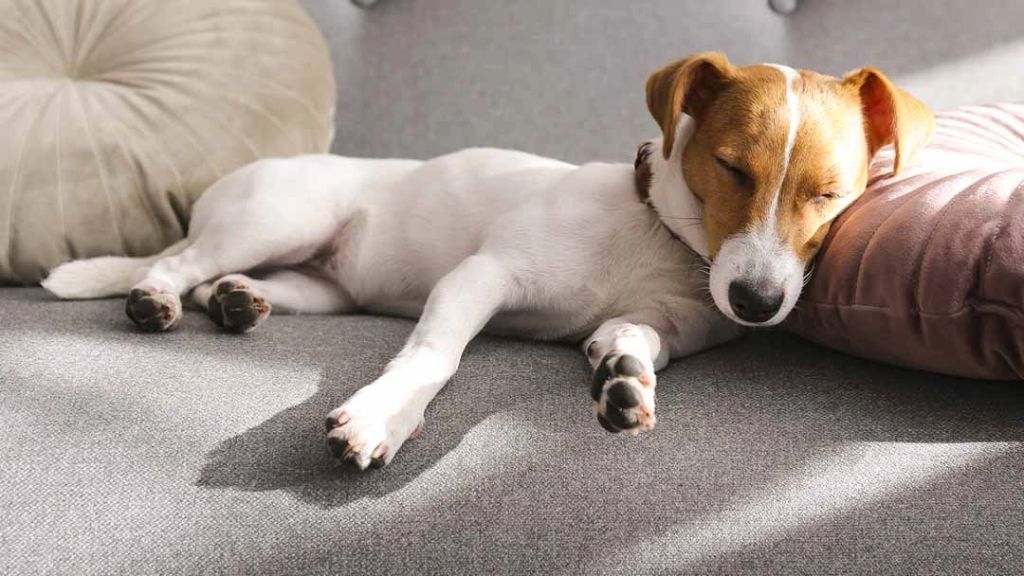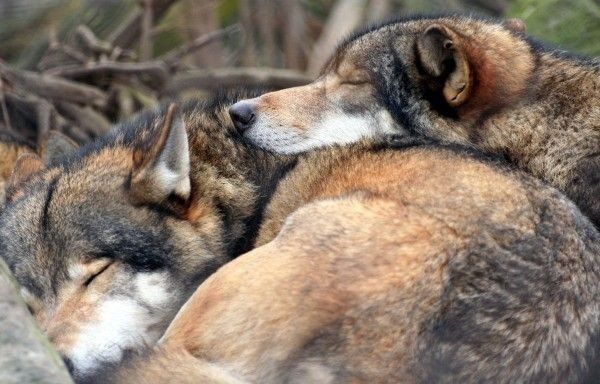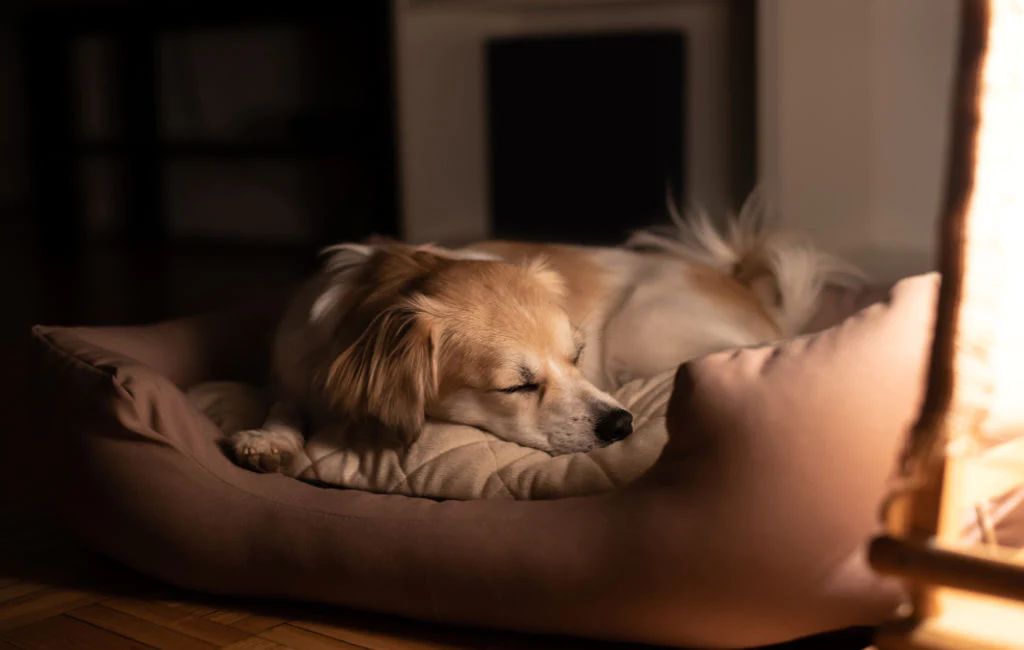Why Do Dogs Sleep in Strange Positions?
Dogs sleep in a variety of strange, silly, and endearing positions. You may find your dog splayed out on its back, legs akimbo, tongue lolling out of its mouth. Or, your pup may snooze curled up in a tight ball with their nose tucked under their tail. While these sleeping positions can seem random, there is meaning behind how dogs sleep.
Understanding why dogs like to sleep in certain positions can provide insight into your pet’s health, personality, and instinctual habits. Learning about proper sleep is also key for dogs to get the rest they need. Though cute and comical at times, monitoring your dog’s sleep can ensure they are sleeping soundly and comfortably.
Theories on Why Dogs Sleep Horizontally
There are several theories as to why dogs tend to sleep horizontally rather than curled up in a ball. Some of the most common theories include:
Temperature Regulation – By sleeping stretched out on their side or stomach, dogs can more effectively regulate their body temperature. Sleeping curled up reduces their surface area exposed to the air, which can cause them to get too warm (Source).
Comfort – Laying horizontally allows dogs to fully extend and stretch out their limbs, which is more comfortable and relaxing for their muscles and joints. It likely feels good to sprawl out (Source).
Health Benefits – Sleeping on their side can help improve dogs’ breathing and circulation compared to being curled up tightly. It may also aid digestion.
Wild Instincts – Stretching out allows dogs to be ready to spring into action at a moment’s notice, an instinct from their wild ancestry. Being able to react quickly is encoded in their DNA.
Temperature Regulation
One of the main reasons dogs tend to sleep horizontally is that it helps them regulate their body temperature. Dogs don’t sweat like humans do and rely mainly on panting to cool down. Sleeping in a stretched out position exposes their entire underside and allows more surface area for heat to dissipate from their body. This is especially important for larger breeds who can overheat more easily. Research shows that dogs will often choose cooler surfaces like tile or wood floors to sleep on as another way to maintain a comfortable body temperature.

Dogs are also more likely to sleep in a horizontal position during warmer weather or in warmer areas of the house. Their legs are stretched out away from their core which enables better air circulation to cool the rest of their body. The increased exposure along their belly also maximizes heat loss. So paying attention to your dog’s sleeping position can provide insight into whether they are getting too hot.
Comfort
Dogs often choose to sleep horizontally because it allows them to fully stretch out their bodies, which is a very comfortable sleeping position for them. When dogs sleep with their legs extended horizontally, it enables them to relax all their muscles and joints. Sleeping on their side also prevents pressure from building up on their limbs and joints while lying down for long periods. Stretching out horizontally can be especially comfortable for larger dog breeds or older dogs with arthritis or other joint issues. According to this source, many owners observe their dogs actively choosing to sprawl out horizontally even when there is plenty of room on the bed to sleep in other positions. This suggests that sleeping on their side with legs extended is simply the most comfortable and relaxing position for most dogs.
Health Benefits
Sleeping horizontally helps keep dogs’ musculoskeletal health in top shape. In this position, their weight is evenly distributed, which reduces pressure on their hips, elbows and shoulders (PetMD). By stretching out on their side, dogs can fully extend their front and back legs, allowing their joints, ligaments and muscles to relax. This prevents stiffness and achess in the limbs that can come from curling up in a ball.
Letting their legs dangle freely while on their side also increases blood circulation to the extremities. The horizontal position helps take pressure off the heart and allows improved blood flow. For senior dogs or those prone to arthritis, sleeping on their side keeps joints limber and prevents pain (Casper).
Overall, the horizontal sleeping position provides ergonomic support for a dog’s entire body. It enables them to fully relax their muscles and experience rejuvenating, restorative sleep.
Safety Precaution
Dogs sleep horizontally to keep a broad view of their surroundings. Sleeping in this position with their legs sprawled gives them a panoramic view which allows them to more easily detect potential predators or threats [1]. In the wild, this would give them time to get up and react quickly. Domesticated dogs retain this instinct even when sleeping indoors.
Horizontal sleeping also makes it easy for dogs to spring into action. With their legs extended, they can stand up rapidly if awoken by a noise or sudden movement. Their muscles aren’t contracted like in a curled up position. Having their legs free and ready enables dogs to be mobile in an instant if needed.
Additionally, sleeping horizontally does not restrict dogs’ breathing. They are able to take full deep breaths as their chest and belly are not compressed. Unobstructed breathing is important for remaining alert and prepared for any dangers that may present themselves.
[1] https://www.petmd.com/dog/general-health/dog-sleeping-positions-and-what-they-mean
Wild Instincts
One theory suggests that dogs sleep horizontally due to their connection with wolves. Wolves are known to sleep curled up with their packs for warmth and protection. Sleeping horizontally may be an instinctual behavior that domestic dogs retained from their ancestors. When wolves sleep together, they arrange themselves horizontally, pressed up against each other in the pack. This sleeping position likely helped wolves conserve body heat and watch for predators.
According to Wolf Connection, an educational wolf sanctuary, wolves prefer to sleep touching their pack members in a horizontal position. This horizontal arrangement allowed the wolf pack to quickly jump up and mobilize if a threat appeared. It also enabled wolves to efficiently transfer body heat between pack members on cold nights. Even though domesticated dogs no longer need to sleep this way for survival, the instinct to lay horizontally may still persist.

Individual Differences
While most dogs tend to sleep in certain common positions, preferences can vary a lot between individuals. Factors like breed, age, size, and health status can impact the way a dog sleeps.
For example, puppies and senior dogs may choose more curled up positions since they have less body heat to retain. Larger breeds like Great Danes often can’t curl up as tightly due to their size. Dogs with certain health conditions, such as arthritis, may avoid positions that put pressure on sore joints.
Breed can also play a role. Sighthounds like Greyhounds are known for sleeping in a curled up nose-to-tail “donut” position to conserve warmth. In contrast, sprawled out positions are more common in hot weather breeds like Labradors. Owners may also notice individual quirks – for example, some dogs always sleep in the same spot or position.
Paying attention to a dog’s preferred sleeping style can provide insight into their unique personality, needs, and health. If positions suddenly change, it may indicate an underlying medical issue warrants a vet visit. Otherwise, it’s important to provide bedding suited to an individual dog’s sleeping habits.
For more on this, see this article on how sleeping positions reflect a dog’s breed, age, and personality.
Tips for Quality Dog Sleep
Getting good quality sleep is important for your dog’s health and wellbeing. Here are some tips to help your canine companion sleep better at night:

Stick to a regular sleep schedule by taking your dog out right before bedtime and waking up at the same time every day. Consistency helps cue the body’s internal clock for sleep (Source 1).
Make the hour before bed relaxed by avoiding overly exciting playtime or too many treats. Try calmer activities like gentle walks or brushing (Source 2).
Limit food and water intake close to bedtime to reduce bathroom breaks. Take your dog out right before bed to empty their bladder (Source 1).
Provide a comfortable sleeping area away from drafts, loud noises, and bright lights. Use blankets and beds to create a cozy space (Source 3).
Consider crate training if your dog has trouble settling. The enclosed space can feel safe and den-like for dogs (Source 3).
Use calming aids like aromatherapy, music, or supplements if approved by your vet. This can reduce anxiety and restlessness at night (Source 3).
Make sure your dog gets enough activity and stimulation during the day to avoid pent-up energy at bedtime. Mental exercise is also important.
If your dog is having persistent sleep issues, consult your veterinarian to rule out any underlying medical conditions.
Conclusion
In summary, there are several theories and explanations for why dogs tend to sleep horizontally:
– Sleeping stretched out allows dogs to better regulate their temperature, especially by exposing their bellies. This may provide cooling in warm weather or retain heat in cool temperatures.
– Lying horizontally can be a more comfortable sleeping position for dogs, allowing their muscles to relax fully. It may reduce stress on joints and limbs.
– Letting their bodies extend out may provide health benefits like improved circulation and better spine alignment.
– Horizontal sleeping with legs stretched away from their bodies may be an instinctive safety precaution, allowing dogs to spring up quickly if needed.
– Some experts believe horizontal sleeping is an innate leftover behavior from wild canine ancestors.
While general trends exist, each dog is an individual with unique sleeping habits and preferences. Providing a comfortable, safe sleeping area tailored to your dog’s needs will allow your pet to get the high-quality sleep they require.

